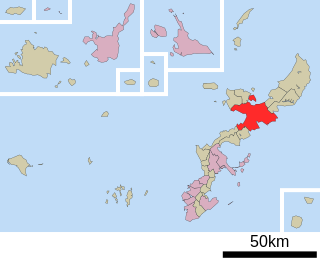 W
WThe 1945 Katsuyama killing incident refers to the murder of three African-American United States Marines in Katsuyama near Nago, Okinawa after the Battle of Okinawa in June 1945. Residents of Katsuyama had reportedly killed the three Marines for their repeated rape of village women during occupation of Okinawa and hidden their bodies in a nearby cave out of fear for retaliation. The Katsuyama incident was kept secret until 1997 and the bodies and identities of the Marines were discovered.
 W
WIn the Battle of Okinawa, Cactus Ridge was the name U.S. forces gave to a rise of land approximately 600 yards (550 m) southeast of Mashiki, Okinawa which commanded much of the ground between Uchitomari and Oyama, both of which lie along Highway No. 1. The defense of Cactus Ridge to the west, and The Pinnacle to the east, marked the start of resistance by Japanese land forces on Okinawa.
 W
WCamp Courtney is a U.S. Marine Base located in Uruma City, Okinawa Prefecture, Japan. It is part of the larger Marine Corps Base Camp Smedley D. Butler and home to the III Marine Expeditionary Force, 3rd Marine Division, and 3d MEB Headquarters. It is named after Major Henry A. Courtney, Jr., who was killed in action in the Battle of Okinawa. Camp Courtney covers 1.339 square kilometres (0.517 sq mi) in the Konbu, Tengan, and Uken districts of Uruma.
 W
WCamp Foster, formerly known as Camp Zukeran, is a United States Marine Corps camp located in Ginowan City with portions overlapping into Okinawa City, Chatan town and Kitanakagusuku village in the Japanese prefecture of Okinawa Island. It is part of the Marine Corps Base Camp Smedley D. Butler complex.
 W
WCamp Gonsalves is a U.S. Marine Corps jungle warfare training area established in 1958, and located in northern Okinawa, Japan, across the villages of Kunigami and Higashi. It is the largest U.S training facility in Okinawa. The camp is located in the Yanbaru forest protected area, raising long time ecological concerns enhanced by the 2016 plan to built new helipads.
 W
WCamp Hansen is a United States Marine Corps base located in Okinawa, Japan. The camp is situated in the town of Kin, near the northern shore of Kin Bay, and is the second-northernmost major installation on Okinawa, with Camp Schwab to the north. The camp houses approximately 6,000 Marines nowadays, and is part of Marine Corps Base Camp Butler, which itself is not a physical base and comprises all Marine Corps installations on Okinawa.
 W
WCamp Kinser is a United States Marine Corps logistics base in Okinawa, Japan.
 W
WCamp Schwab is a United States Marine Corps camp located in northeastern Okinawa Prefecture, Japan, that is currently home to the 4th Marine Regiment and other elements of the 28,000 American servicemen based on the island. The Camp was dedicated in 1959, in honor of Medal of Honor recipient Albert E. Schwab, who was killed in action during the Battle of Okinawa.
 W
WMarine Corps Air Station Futenma or MCAS Futenma is a United States Marine Corps base located in Ginowan, Okinawa, Japan, 5 NM northeast of Naha, on the island of Okinawa. It is home to approximately 3,000 Marines of the 1st Marine Aircraft Wing and other units, and has been a U.S. military airbase since the defeat of the Japanese Imperial Army in the Battle of Okinawa in 1945. Marine Corps pilots and aircrew are assigned to the base for training and providing air support to other land and sea-based Marines in Okinawa and throughout the Asia-Pacific region. MCAS Futenma is part of the Marine Corps Installations Pacific command.
 W
WIrisuna-jima (入砂島), also known as Idesuna-jima (出砂島), is an uninhabited island in Tonaki, Okinawa Prefecture, Japan. It lies approximately four kilometres to the west of Cape Watanjisaki (ワタンジ崎), the northwest tip of Tonaki Island. Ceramics, including kamui ware and celadons, are evidence of human activity on the island over the longue durée. Public access is now prohibited since, under the designation FAC 6078, Idesuna Jima Range (出砂島射爆撃場) is a live-fire training area for the United States Forces Japan.
 W
WKadena Air Base is a United States Air Force base in the towns of Kadena and Chatan and the city of Okinawa, in Okinawa Prefecture, Japan. It is often referred to as the "Keystone of the Pacific". Kadena Air Base is home to the USAF's 18th Wing, the 353d Special Operations Group, reconnaissance units, 1st Battalion, 1st Air Defense Artillery, and a variety of associated units. Over 20,000 American servicemembers, family members, and Japanese employees live or work aboard Kadena Air Base. It is the largest and most active US Air Force base in the Far East.
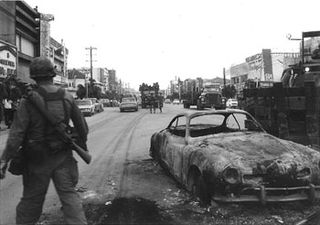 W
WThe Koza riot was a violent and spontaneous protest against the US military presence in Okinawa, which occurred on the night of December 20, 1970, into the morning of the following day. Roughly 5,000 Okinawans clashed with roughly 700 American MPs in an event which has been regarded as symbolic of Okinawan anger against 25 years of US military occupation. In the riot, approximately 60 Americans and 27 Okinawans were injured, 80 cars were burned, and several buildings on Kadena Air Base were destroyed or heavily damaged.
 W
WMarine Corps Base Camp Smedley D. Butler is a United States Marine Corps base located in the Japanese prefecture of Okinawa. It was named after Marine Corps Major General and twice Medal of Honor recipient Smedley D. Butler.
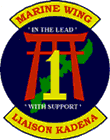 W
WMarine Wing Liaison Kadena (MWLK) is a United States Marine Corps logistics and liaison unit based at Kadena Air Base on Okinawa, Japan. They fall under 1st Marine Aircraft Wing and III Marine Expeditionary Force
 W
WThe Naha Port Facility, formerly the Naha Military Port, is a United States Forces Japan facility located in Naha, Okinawa, Japan, at the mouth of Kokuba River , which flows into the East China Sea.
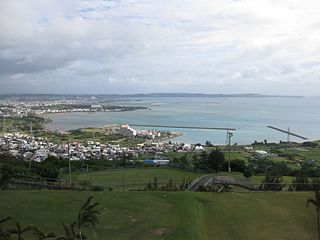 W
WNakagusuku Bay is a bay on the southern coast of Okinawa Island on the Pacific Ocean in Japan. The bay covers 220 square kilometres (85 sq mi) and ranges between 10 metres (33 ft) to 15 metres (49 ft) deep. The bay is surrounded by the municipalities of Uruma, Kitanakagusuku, Nakagusuku, Nishihara, Yonabaru, Nanjō, all in Okinawa Prefecture. In 1852, while visiting the Ryukyu Kingdom, Commodore Matthew Perry mapped Okinawa and labeled Nakagusuku Bay as "Perry's Bay". During the final months of World War II, the bay became a U.S. Navy forward base, and was nicknamed "Buckner Bay".
 W
WThe Battle of Okinawa , codenamed Operation Iceberg, was a major battle of the Pacific War fought on the island of Okinawa by United States Marine and Army forces against the Imperial Japanese Army. The initial invasion of Okinawa on April 1, 1945, was the largest amphibious assault in the Pacific Theater of World War II. The Kerama Islands surrounding Okinawa were preemtively captured on March 26th, (L-6) by the 77th Infantry Division. The 98-day battle lasted from March 26th until July 2nd, 1945. After a long campaign of island hopping, the Allies were planning to use Kadena Air Base on the large island of Okinawa as a base for Operation Downfall, the planned invasion of the Japanese home islands, 340 mi (550 km) away.
 W
WThe American invasion of island of Okinawa, codenamed Operation Iceberg, took place 1 April 1945. The Japanese military was determined to inflate a casualty rate so high that the U.S. government would choose not to invade the Japanese home islands. To this end, the southern portion of the island had been covered with the most extensive system of fortifications and fields of fire yet encountered in the Pacific War.
 W
WThe 1959 Okinawa F-100 crash, also known as the Miyamori Elementary School crash (宮森小学校米軍機墜落事故), occurred on June 30, 1959, when a North American F-100 Super Sabre of the United States Air Force crashed in Ishikawa, in United States-occupied Okinawa, killing 18 people.
 W
WOver the last five decades there have been various plans for the relocation of Marine Corps Air Station Futenma, a United States Marine Corps base located within the urban area of Ginowan City in Okinawa, Japan.
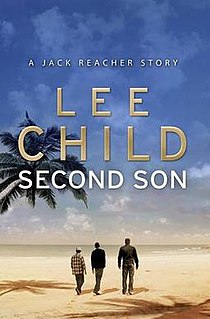 W
W"Second Son" is a short story featuring Jack Reacher, a fictional character created by British author Jim Grant. The story is a prequel to the novel series and gives a glimpse of the teen-age Reacher. "Second Son" was released originally for the Kindle and, in 2017, was included in No Middle Name, a collection of Jack Reacher short stories. "Second Son" was bundled with the movie Jack Reacher as a Target Exclusive, when the movie was released on Blu-ray on 7 May 2013.
 W
WThe Special Action Committee on Okinawa is a formal agreement made between the United States Government and the Government of Japan. The U.S. and the Japanese government established the SACO agreement on November 1995. About 75% of land area of exclusive-use U.S. military installations in Japan exist on the island of Okinawa. The Agreement was brought on by a political uprising that escalated when an Okinawan schoolgirl was abducted and raped by three U.S. servicemen in September 1995. The agreement's purpose was to reduce the impact of the U.S. military presence on the people of Okinawa. The SACO developed recommendations to realign, consolidate, and reduce U.S. facilities and adjust operational procedures. In December 1996, the United States agreed to return 21% of the land in Okinawa from 11 U.S. military installations. The final report of the SACO outlines the requirements of returning land, adjusting training and operational procedures, implementing noise abatement procedures, and changing the Status of Forces Agreement (SOFA) procedures.
 W
WUS Army Garrison Okinawa is a United States Army facility located in Yomitan, Okinawa Prefecture, Japan. Home to the United States Army on Okinawa, 10th Support Group (Regional), along with the 1st Battalion, 1st Special Forces Group (Airborne), 247th MP DET, and the 349th Signal Company provide support to all other U.S. military services on the island. Formerly named 'Torii Station', the garrison was re-designated in March 2014.
 W
WThe Treaty of Mutual Cooperation and Security between the United States and Japan , also known in Japan as Anpo jōyaku (安保条約) or just Anpo (安保) for short, is a treaty establishing a military alliance between the United States and Japan. The treaty was first signed in 1951 at the San Francisco Presidio after the signing of the Treaty of San Francisco at the San Francisco War Memorial Opera House. Then, the Security Treaty was amended further in January 1960 between the US and Japan in Washington, DC.
 W
WThe U.S.-Japan Alliance is a military alliance between Japan and the United States of America, as codified in the Treaty of Mutual Cooperation and Security Between the United States and Japan, which was first signed in 1951, took effect in 1952, and was amended in 1960. The alliance has further been codified in a series of "administrative" agreements, "status of forces" agreements, and secret pacts that have not been subject to legislative review in either country.
 W
WU.S.–Japan Status of Forces Agreement is an agreement between Japan and the United States signed on 19 January 1960 in Washington, the same day as the revised U.S.-Japan Security Treaty. It is a status of forces agreement (SOFA) as stipulated in article VI of that treaty, which referred to "a separate agreement" governing the "use of [...] facilities and areas [granted to the U.S.] as well as the status of United States armed forces in Japan". It replaced the earlier "U.S.-Japan Administrative Agreement" that governed such issues under the original 1951 security treaty.
 W
WThe United States Forces Japan (USFJ) is an active Subunified Command of the United States Indo-Pacific Command (USINDOPACOM). It was activated at Fuchū Air Station in Tokyo, Japan, on 1 July 1957 to replace the Far East Command (FEC). USFJ is commanded by the Commander, U.S. Forces, Japan (COMUSJAPAN) who is also dual-hatted as commander of the Fifth Air Force. At present, USFJ is headquartered at Yokota Air Base in Tokyo.
 W
WAlbert Watson II was a United States Army lieutenant general. He participated in World War II and fought in a number of significant battles in the Pacific Theater, including the Battle of Okinawa. From May 1961 to January 1963, Watson served as Commandant of Berlin and commanded American military forces there when construction of the Berlin Wall began. A major diplomatic incident occurred when members of Watson's staff were refused access to East Berlin. Riots also broke out during his tenure following the death of Peter Fechter. From 1964 to 1965, Watson filled the position of Commissioner of the United States Civil Administration of the Ryukyu Islands. He increased Ryuku autonomy but ultimately spoke against the significant lessening of American administration authority in the Ryukyus. Watson received two Army Distinguished Service Medals during his career.